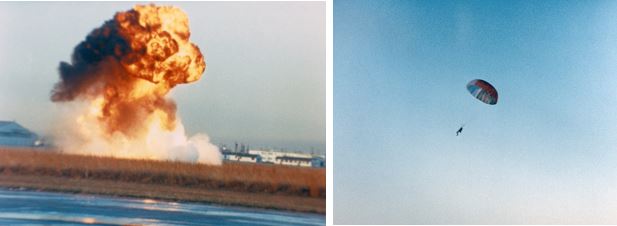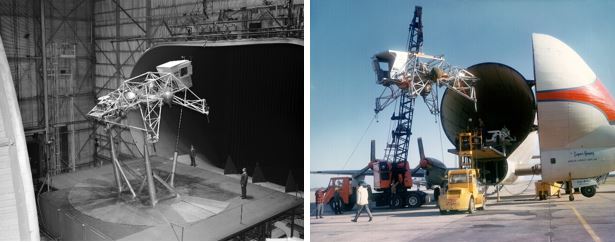The Lunar Landing Training Vehicle (LLTV) was a critical tool for astronauts training to land on the Moon. But as Neil Armstrong summarized it, “It was a contrary machine, and a risky machine, but a very useful one.” The first man to land a Lunar Module (LM) on the Moon had personal experience with the fickle nature of the training vehicle. On May 8, 1968, while flying a predecessor of the LLTV called the Lunar Landing Research Vehicle (LLRV) at Ellington Air Force Base near the Manned Spacecraft Center (MSC), now the Johnson Space Center, in Houston, Armstrong averted disaster by mere seconds. He ejected from the craft when sensors failed to tell him that he was out of attitude control fuel and he lost control of the vehicle. He parachuted to safety but the LLRV crashed and was damaged beyond repair. NASA grounded the remaining vehicles and MSC Director Robert L. Gilruth established an accident review board, chaired by MSC Aircraft Operations Office Chief Joseph S. “Joe” Algranti. The board released its report on Oct. 17, making several recommendations to make the training vehicles safer. A flight readiness review on Nov. 26 cleared the LLTVs to resume astronaut training.
Bell Aerosystems of Buffalo, NY, built two copies of the LLRV and three of the LLTV. The LLRVs were first flown and tested at NASA’s Flight Research Center (FRC), now the Armstrong Flight Research Center, at Edwards Air Force Base in California, before being transferred to Ellington in December 1966. LLRV-1 made 84 flights there (46 of them by astronauts) before Armstrong’s crash, while LLRV-2 never flew at Ellington, being used for spares to support the first vehicle. Bell delivered the LLTV’s to Houston in October and December 1967, and included improvements over their predecessors that made them higher fidelity simulators of the LM, especially of the final 200 feet of the landing. Algranti piloted the LLTV-1 vehicle during its maiden flight, on Oct. 3, 1968. During the next two months, Algranti and fellow MSC pilot H.E. “Bud” Ream completed 14 test flights with LLTV-1 to check out the vehicle. Ream also piloted LLTV-2’s first two flights beginning Dec. 5.
During LLTV-1’s 15th flight on Dec. 8, the final certification flight before resuming astronaut training, pilot Algranti took the vehicle to 680 feet altitude and began a lunar landing simulation run. The vehicle began to oscillate in all three axes, which Algranti tried to control. But unexpected wind shear exceeded the craft’s aerodynamic control limits and it began a sudden descent. At 100 feet altitude, and with less than a second to spare, Algranti ejected and safely parachuted to the ground with only minor bruises but LLTV-1 crashed and was a total loss.
Once again, NASA grounded the LLTVs and MSC Director Gilruth set up an investigation board, this time chaired by NASA astronaut Walter M. Schirra. To better understand the vehicle’s aerodynamic characteristics, in late December NASA shipped LLTV-3 to the Langley Research Center in Hampton, Virginia, where engineers tested it in the wind tunnel. Findings from the board and from the Langley tests indicated that a gust of wind that overwhelmed the vehicle’s control limits caused the LLTV-1 crash and that it was unrelated to the previous LLRV accident. Recommendations included increasing the level of thrust in the craft’s thrusters by 50 percent to provide an additional margin of safety. The LLTVs were cleared to fly again and Ream made a test flight in LLTV-2 on Apr. 7, 1969. Soon after, engineers discovered that search radars at Ellington caused significant electromagnetic interference once more temporarily grounding LLTVs. That problem was solved by turning the radars away from the LLTV test area during flights.
Management cleared Armstrong to fly LLTV-2 in June 1969, and he completed his final training flights just four weeks prior to the Apollo 11 mission. Armstrong made 21 flights in the LLRV prior to the May 1968 crash and 8 in the LLTV in June 1969. He credited this valuable experience with being able to successfully guide the LM Eagle to the lunar surface on July 20, 1969, meeting President John F. Kennedy’s goal of landing a man on the Moon before the end of the decade.
Read Algranti’s oral history with the JSC History Office. For additional first-hand accounts, also read oral histories with Charles R. Haines, LLTV Program Manager in the Aircraft Operations Office between 1969 and 1973, and Donald L. Mallick, chief project pilot on the LLRV at Dryden, who also helped develop the procedures used in the lunar landing.
For more on LLRVs and LLTVs, read https://www.hq.nasa.gov/alsj/LLRV_Monograph.pdf





























